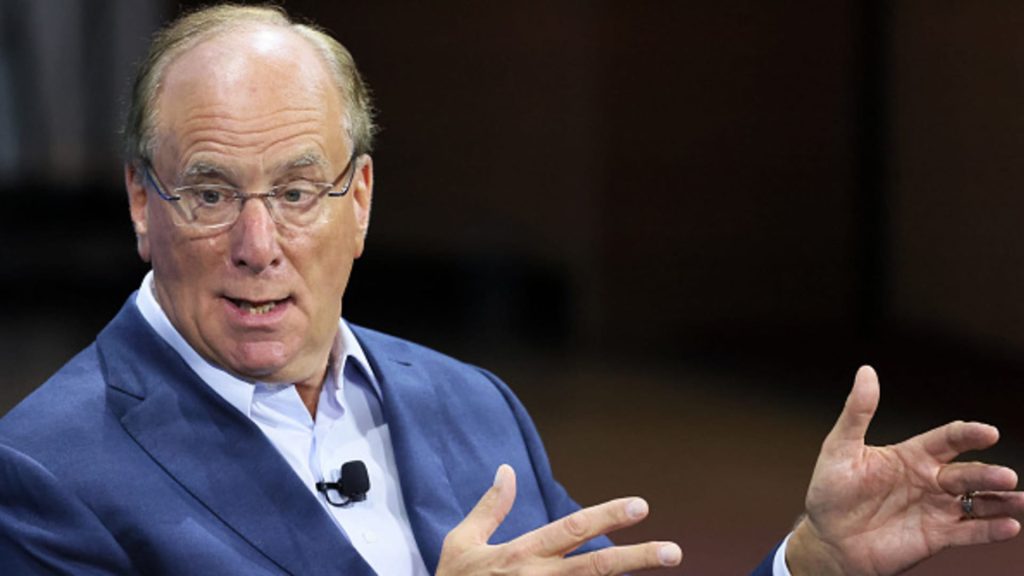Andrew Ross Sorkin speaks with BlackRock CEO Larry Fink during the New York Times DealBook Summit in the Appel Room at the Jazz at Lincoln Center in New York City on Nov. 30, 2022.
Michael M. Santiago | Getty Images
It may be time to rethink the traditional 60/40 investment portfolio, according to BlackRock CEO Larry Fink.
In a new letter to investors, Fink writes the traditional allocation comprised of 60% stocks and 40% bonds that dates back to the 1950s “may no longer fully represent true diversification.”
“The future standard portfolio may look more like 50/30/20 — stocks, bonds and private assets like real estate, infrastructure and private credit.” Fink writes.
Most professional investors love to talk their book, and Fink is no exception. BlackRock has pursued several recent acquisitions — Global Infrastructure Partners, Preqin and HPS Investment Partners — with the goal of helping to increase investors’ access to private markets.
More from Personal Finance:
Why uncertainty makes the stock market go haywire
Investors are ‘miles ahead’ if they avoid 3 things, CIO says
How investors can ready their portfolios for a recession
The effort to make it easier to incorporate both public and private investments in a portfolio is analogous to index versus active investments in 2009, Fink said.
Those investment strategies that were then considered separately can now be blended easily at a low cost.
Fink hopes the same will eventually be said for public and private markets.
Yet shopping for private investments now can feel “a bit like buying a house in an unfamiliar neighborhood before Zillow existed, where finding accurate prices was difficult or impossible,” Fink writes.
60/40 portfolio still a ‘great starting point’
After both stocks and bonds saw declines in 2022, some analysts declared the 60/40 portfolio strategy dead. In 2024, however, such a balanced portfolio would have provided a return of about 14%.
“If you want to keep things very simple, the 60/40 portfolio or a target date fund is a great starting point,” said Amy Arnott, portfolio strategist at Morningstar.
If you’re willing to add more complexity, you could consider smaller positions in other asset classes like commodities, private equity or private debt, she said.
However, a 20% allocation in private assets is on the aggressive side, Arnott said.
The total value of private assets globally is about $14.3 trillion, while the public markets are worth about $247 trillion, she said.
For investors who want to keep their asset allocations in line with the market value of various asset classes, that would imply a weighting of about 6% instead of 20%, Arnott said.
Yet a 50/30/20 portfolio is a lot closer to how institutional investors have been allocating their portfolios for years, said Michael Rosen, chief investment officer at Angeles Investments.
The 60/40 portfolio, which Rosen previously said reached its “expiration date,” hasn’t been used by his firm’s endowment and foundation clients for decades.
There’s a key reason why. Institutional investors need to guarantee a specific return, also while paying for expenses and beating inflation, Rosen said.
While a 50/30/20 allocation may help deliver “truly outsized returns” to the mass retail market, there’s also a “lot of baggage” that comes with that strategy, Rosen said.
There’s a lack of liquidity, which means those holdings aren’t as easily converted to cash, Rosen said.
What’s more, there’s generally a lack of transparency and significantly higher fees, he said.
Prospective investors should be prepared to commit for 10 years to private investments, Arnott said.
And they also need to be aware that measurement issues with asset classes like private equity means past performance data may not be as reliable, she said.
For the average person, the most likely path toward tapping into private equity will be part of a 401(k) plan, Arnott said. So far, not a lot of companies have added private equity to their 401(k) offerings, but that could change, she said.
“We will probably see more plan sponsors adding private equity options to their lineups going forward,” Arnott said.

